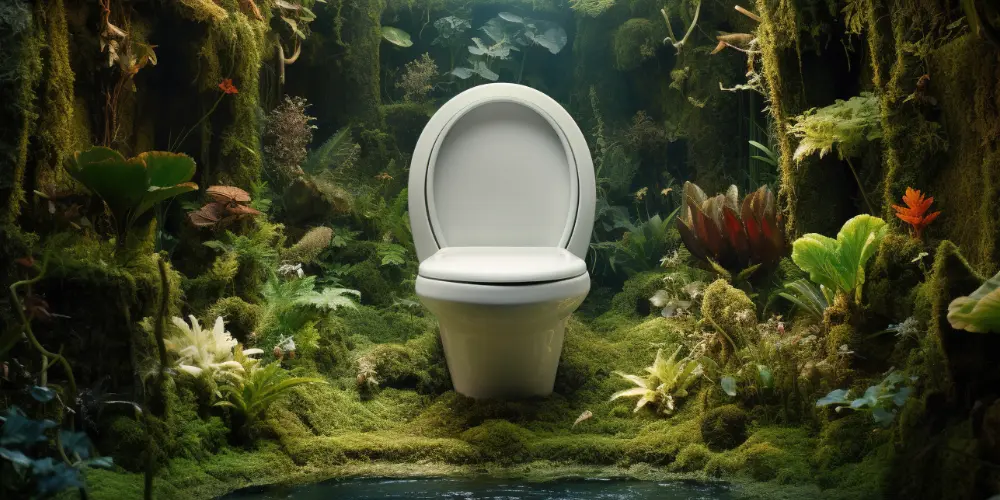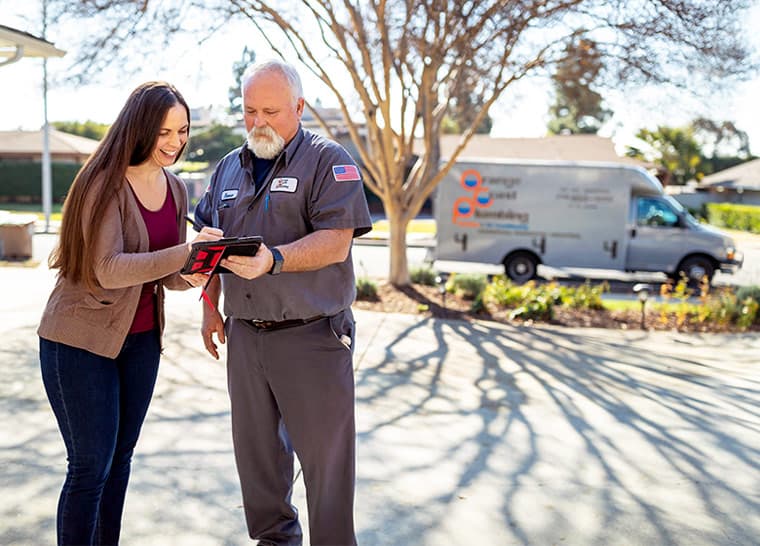Low-flow toilets can save up to 2 gallons of water per flush or up to 20 gallons per day for a household of four.
Advanced low-flow toilets use 1.28 gallons per flush or 77% less water than conventional toilets.
Low flow is good.
Slow flow or no flow is, well, problematic. A toilet is the one genuinely indispensable fixture in your home. Plus, a malfunctioning toilet can be a health hazard.
Here, we list a few common low-flow toilet issues you can resolve without calling a plumber.
How Low-Flow Toilets Work
Unlike conventional toilets, which typically use around 3.5 to 7 gallons per flush, low-flow models are designed to do the job with significantly less water — 1.6 gallons per flush or even less.
They achieve this:
- By designing the bowl and trapway to boost the force of the flush
- In some cases, by using high-pressure flushing mechanisms
Low-flush toilets are better for the environment and your wallet. However, their more complex design makes them susceptible to the issues we list below.
Common Low-Flow Toilet Problems
1. Clogging
Low-flow toilets have smaller passages and use less water, making them prone to clogging if operated and maintained incorrectly.
What to do:
- Avoid flushing anything other than toilet paper and human waste.
- Use a toilet plunger (not a cup plunger) to clear minor clogs.
- Consider using a toilet auger for tougher clogs.
- Apply natural solutions like baking soda and vinegar or enzyme-based cleaners to prevent buildup in the pipes.
2. Weak Flush
A weak flush often stems from blockages in the jet holes or issues with the toilet’s internal components.
What to do:
- Use a small mirror to inspect the jet holes under the toilet’s rim. Clear any blockages with a wire hanger or vinegar.
- Ensure the tank’s water level is high enough to provide adequate flushing pressure.
- If your toilet has an adjustable flush valve, experiment with the settings to increase the flush strength.
- Replace the flapper valve if it’s old or damaged. You can soften it with Vaseline as a temporary fix.
3. Ghost Flushing
If your toilet begins to flush itself intermittently — termed “ghost flushing” — the usual suspect is a slow leak from the tank into the bowl.
What to do:
- Check the seal of the flapper valve in the tank for wear and tear.
- Ensure the chain isn’t too tight, causing the flapper to lift slightly without a flush.
- Test for leaks by adding a few drops of food coloring to the tank. Then, wait to see if it seeps into the bowl without a flush.
- Replace the flapper or its seat if you find evidence of leaks.
5. Constant Running
A faulty flapper or fill valve can lead to the tank continuously filling with water.
What to do:
- Adjust the float arm of the fill valve so that it sits just below the top of the overflow pipe when the tank is full.
- Clean any sediment buildup on the fill valve’s inlet screen by unscrewing it from the bottom of the tank.
- Replace the fill valve and flapper if they’re old or damaged.
6. Seal Leakage
Leaks around the toilet base often result from a worn or damaged wax seal.
What to do:
- Turn off the water supply and flush to remove all remaining water in the tank and bowl.
- Unscrew the bolts securing the toilet to the floor. Replace the wax ring with a new one.
- Tighten any loose bolts or screws connecting various parts of your toilet.
Maintenance Tips for Low-Flow Toilets
Proper maintenance is key to preventing low-flow toilet problems. Here are some pointers to keep your toilet functioning smoothly:
- Regularly check for leaks in the toilet tank and bowl to prevent water waste and potential damage.
- Clean the jet holes and siphon tube regularly to ensure optimal flushing action and prevent blockages.
- Don’t use caustic toilet bowl cleaners, which can damage the internal components. Opt for mild, non-abrasive cleaners instead.
- Inspect the components inside the tank, such as the flapper and fill valve, at least twice a year for signs of wear or corrosion. Replace them as necessary.
- Be cautious with “drop-in” chlorinated toilet fresheners; they can degrade parts inside the tank.
- Manage mineral buildup by periodically applying a mixture of vinegar and water to affected areas.
- Educate household members about what should and shouldn’t be flushed to avoid clogs and damage to the sewer system (are you hearing this, toddlers?).
When to Call a Professional
There are times when it’s best to seek professional help. You should call a licensed plumber when:
- You’ve repeatedly tried to resolve a clog or other problems, but the issue persists.
- You notice signs of water damage or persistent leaks.
- There’s a significant drop in water pressure throughout your home, not just at the toilet.
- You smell foul odors that could indicate a sewer line problem.
- The toilet requires repairs that involve the sewer or plumbing systems.
In Orange County, CA, Orange Coast Plumbing is your reliable partner for all plumbing needs. We’re on standby for any plumbing emergency and are here to ensure those emergencies happen less often with preventive maintenance services.
Don’t let toilet troubles ruin your day — give us a call!
Frequently Asked Questions about Low-Flow Toilets
Q: How do I know if my toilet is low flow?
A: Low-flow toilets are typically labeled as such and have a volume of 1.6 gallons per flush or less.
Q: Can I retrofit my existing toilet to make it low-flow?
A: You can retrofit your toilet with a low-flow conversion kit or install a water-saving flush valve.
Q: Why does my low-flow toilet keep getting clogged?
A: Low-flow toilets may struggle to clear waste effectively due to their reduced water volume per flush. Proper use and maintenance can mitigate clogging issues.
Q: How often should I perform maintenance on my low-flow toilet?
A: We recommend regular maintenance on your low-flow toilet, including cleaning and inspection, at least once every few months to ensure optimal performance and longevity.
Q: Are all new toilets low-flow by default?
A: Most new toilets installed today are low-flow models to meet federal and state water-efficiency standards. They use 1.6 gallons per flush or less, adhering to the guidelines of the Environmental Protection Agency.
Q: Is there a significant cost difference between standard and low-flow toilets?
A: The upfront cost of low-flow toilets can be slightly higher than standard models; however, they save money in the long run through reduced utility bills.
Q: Will using a low-flow toilet affect my septic system?
A: Low-flow toilets reduce the amount of water flowing into septic systems, which lessens the risk of flooding the system and promotes its longevity. However, always ensure your low-flow toilet flushes effectively to avoid clogs or waste accumulation in the system.
Q: How can I improve the flushing power of my low-flow toilet?
A: Regularly clean the rim jets and siphon jet hole. Ensure the tank’s water level is correctly adjusted for maximum flush efficiency and that the internal components, like the flapper and flush valve, are in good working order.
Q: Can I put toilet cleaning tablets in my low-flow toilet tank?
A: Avoid drop-in bleach tablets or other in-tank cleaning agents, as they can corrode internal components. Instead, use mild cleaners in the bowl and periodically clean the tank components by hand.
Q: How can I test my toilet for ‘phantom flushes’ or other leaks?
A: Place a few drops of food coloring into the toilet tank and wait 15-20 minutes. If the color appears in the bowl without flushing, this indicates a leak. Common causes include a faulty flapper or an improper chain length that needs adjustment.


